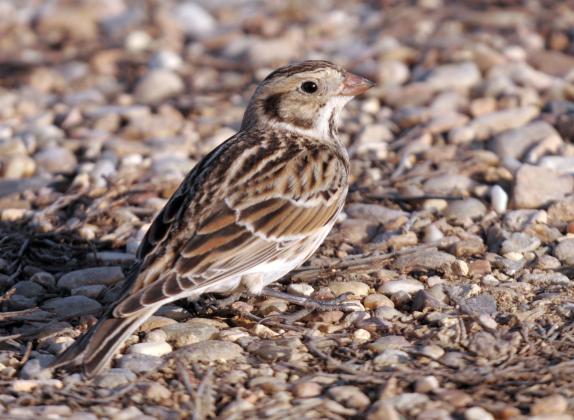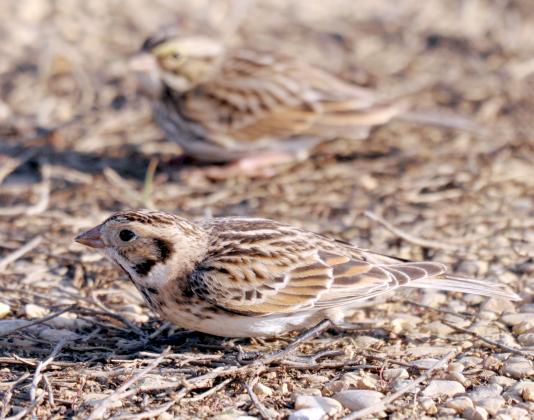The Lapland longspur is a common winter visitor to Oklahoma that isn’t commonly seen.
In fact, I would say people rarely ever “see” them. And by that, I mean identify them, which is not easy to do.
In winter, longspurs resemble sparrows, a group of birds which, in itself, is difficult to differentiate between the species, so many people think a longspur is just another sparrow when they see one.
In fact, I recently saw about a dozen Savannah sparrows feeding on the ground and neglected to see that there was a longspur in the mix. When the birds flushed briefly, I heard the call of the Lapland longspur and located it pretty quickly after that. Their common flight call is a dry “prrrt,” often repeated.
That’s why it is always a good idea to scan groups of common birds for the odd visitor.
The Lapland longspur is one of four species of longspur in North America, and it is probably the most common. In fact, it is one of the most abundant breeding songbirds on the continent.
Of the four species, it is also the only one that breeds outside of North America. According to the Cornell Lab of Ornithology, the Lapland longspur’s range encircles the northern reaches of the Northern Hemisphere, and it is a common breeding bird in Eurasia, where it’s known as “Lapland bunting.”
The Cornell Lab reports that the name Lapland refers to the Lapland region of Scandinavia, which is partly in Sweden and partly in Finland. The name “longspur” refers to the unusually long hind claws that longspurs have.
Lapland longspurs are ground feeders and often flock with other species such as sparrows, pipits and horned larks.
Appearance
In winter, Lapland longspurs have heavily streaked backs and crowns with clean napes. They have dark lines which outline the ears, and black-tipped, dull orange bills.
Additionally, they have rusty patches on the wings.
During the breeding season, males look completely different from their winter plumage, and are white in the front, have black faces, yellow bills and the backs of the heads are rusty-red in color.
Range
The Lapland longspur can be found all over Oklahoma in winter. It’s winter range includes most of the United States, save for Arizona and parts of New Mexico. It breeds in the arctic tundra.
Habitat
In winter, Lapland longspurs prefer open, treeless habitats with short grass or bare ground.
Diet
Lapland longspurs eat seeds from grasses and other plants year-round, but also eat insects during the breeding season.
One last word
I’d like to say something about Carl Lewis, a good friend and Managing Editor of Southwest Chronicle.
I think I speak for everyone when I say his sudden passing this week was a shock.
Carl and I became friends years ago when we both in worked in Ada, Oklahoma, for a managing editor who, to be honest, was quite brutal. When you work for a person where nothing is ever good enough, it’s nice to talk it over with someone who is experiencing the same thing as you.
And that’s just what we did. It made working there bearable, and a bond was formed.
We joked often, and razzed each other as well. If you wanted to get Carl riled up, you just had to tell him that the new Apple phone was basically the same as the previous one. Then, the lecture was on as Carl was a self-described Apple fan. And fanatic would be the correct term. He would explain every new feature, whether or not you wanted to hear it.
Over the years, we bounced ideas off of each other, and he was always available if you had a question about anything. Sometimes, he would call me just to vent about something, and I would do the same.
He was very intelligent, and a great writer. And I am eternally grateful that he allowed me to write this column for Southwest Chronicle.
So, rest in peace, old friend. You will be missed.
• Remember to check out my Randy’s Natural World YouTube channel: www.youtube.com/user/randyadventure.
Editor’s Note: Randy Mitchell is a freelance writer and photographer. He has been an avid birdwatcher, nature enthusiast and photographer for more than 40 years. Reach him at rnw@usa.com.



